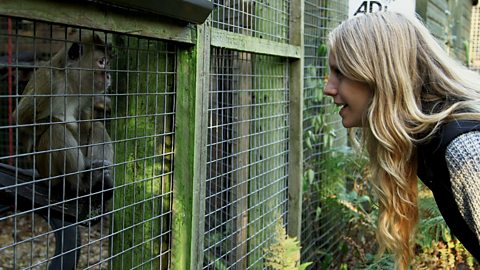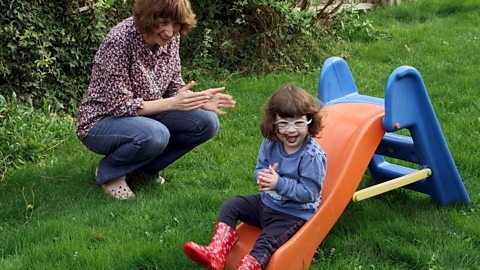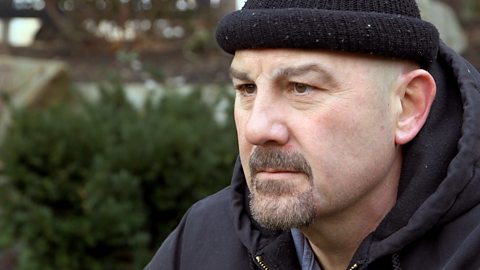Voice over:
What if you had a child with a terminal illness and the only way to save him was to have another child – a saviour sibling? What would you do?
Ami:
We wanted to do anything we could to save our son. We decided to create a saviour sibling.
Voice over:
But is this the right reason to have a child?
Simon:
Children need to be born because they were wanted, not because they’re being used as a tool for some other means.
Voice over:
Two personal takes on a difficult question.
What do you think?
Is it OK to have a child to save another?
Ami:
My name’s Ami and I believe having a saviour sibling is an acceptable thing to do to save another child’s life.
When Jivan was born we were expecting a fully healthy baby. We named him Jivan, which meant life. From the moment he was born he started developing symptoms. He had severe rashes all over his body. The more he itched the more it would start to open and cut then start to bleed. You can imagine a 6 month old burning, all over his body. It’s very painful.
Jivan was diagnosed with Wiskott-Aldrich. The easiest way to describe it is like as if he’s a bubble boy. He wasn’t allowed to touch anything. His life expectancy was not past his 10’s.
We were told that there was only one real cure for him. That was to have a bone marrow transplant from a matching donor, that would match 100% the blood type and the tissue type. We realised quite quickly that there was no real chance of finding a bone marrow match. For an Asian it was actually one in a quarter million.
The consultants told us that there’s this new technology that you can actually create a sibling donor. That would actually match completely so they could give their bone marrow to the child in need.
We wanted to do anything we could to save our son. And we had to do something quite quickly otherwise his body would start to deteriorate. We decided to create a saviour sibling.
Our daughter was born and we named her Jaya and the meaning behind Jaya is victorious so we were hoping she would be victorious in saving her brother’s life. From the moment she was born she was very strong, unbelievably strong, as if she knew she had a mission to donate her bone marrow. My husband and I were very happy to have her be put under general anaesthetic, to go through this procedure because her health was so good. Jaya was 6 months old when she donated bone marrow to Jivan.
It was 100% accepted in his body. So his bone marrow right now is 100% Jaya’s. After almost 2 years he’s going to school, he can go to the playground. He can touch what everyone else touches. He can do anything that normal children can do. So it seems that he’s completely cured.
We were planning on having more children after Jivan anyways. We didn’t do this to design a child of a specific hair colour, eye colour. We had to go through this route in order to save our son.
Reincarnation is the belief that after you die you get reborn again and again and again. So she has given to him and she has saved his life, I’m sure that he has saved hers in a past life and if not then he will do something for her in the future so there’s always going to be a balance.
They both have a different place in our hearts for different reasons and Jaya will not be treated differently in any way because she came to help her brother. It would be no different than if we just created a normal child.
Jivan is very aware that his sister helped him. She has lovingly given everything that she could to save her brother.
Voice over:
It’s very rare for people in the UK to go through the process of creating a Saviour Sibling – only 4 were born in 2012, even fewer in other years. But that doesn’t make it any less controversial. Here’s a different perspective on the issue.
Simon:
My name’s Simon and I believe we have to see a child as a human being first, not as an object to be used for his or her genetic material.
I think an important part of our makeup as humans and our psychology is to know that you’re loved and valued for who you are.And the problem with a saviour sibling, is just by using that title you’re saying that they have a value outside of themselves, that their value is in what they can do, what they were born to do.
Children should be wanted as people for who they are.
I’m a biochemist working at the university of Portsmouth. I went into science originally because I think it’s really interesting and exciting, and it’s great to find out about things that no-one else knows about. So there’s this element of exploration. The main role that science has had in our society is to make a discovery about the world and apply it in terms of a technology. And sometimes people get too carried away with the end, with the technology that’s being invented and don’t think about what happens along the way. The ends don’t justify the means.
So although saving a life is obviously a very high cause one has to consider the harm that might come about in doing that.
And make sure you consider the good and the benefit of that child as much as the good and the benefit of that child that’s currently sick and needing the help.
There’s also the risk that if they weren’t able to save their sibling, and the fact is that’s probably quite likely to happen, that they could find themselves in the position that they know that they were born as a saviour sibling and yet their sibling still died. A significant level of harm could be done psychologically to the child.
Generally people should be able to make decisions about what happens to them. And obviously the child that’s born has absolutely no choice to be part of this process of helping their sibling.
I’ve got two sons and when my oldest son was 3 weeks old he had a very significant heart problem and was in intensive care. The doctor did actually come and talk to us and said you need to prepare yourself, your son’s not going to make it. Thank God he pulled through and is absolutely fine.
But as a parent in that situation I was prepared to do absolutely anything it would take for my son to get better, including if we needed a saviour sibling at that point I’d have very happily gone in for that sort of thing. And all my nice ethical reasoning flew out the window when it was to do with the well being of my son. Which is why it’s very important when decisions are made about what one should or shouldn’t do in a situation, it’s made by people who have that little bit of distance. Because if you were to allow parents who were in that situation to make up all the rules and the laws a lot more would be permissible.
Being in that sort of situation, and having those feelings is not a good basis for ethical decision making. Children need to be born because they were wanted, not because they’re being used as a tool for some other means.
Voice over:
Representatives of different faiths and beliefs how they felt about the question of Saviour Siblings.
David:
From a Catholic perspective it is important that every child is welcomed and welcomed every child is welcomed unconditionally. And therefore to have a child of a particular kind for the sake of someone else is not fair to that child.
The Catholic church has objections to in vitro fertilization. It objects to the substituting of technology for reproduction – for procreation, through sexual intercourse. And it also objects to the destruction of human embryos. And the in vitro fertilization has lead to the destruction of millions of embryos worldwide.
Part of the Catholic objection to assisted reproduction, to IVF, is that it involves quality control. This is seen particularly in Saviour Siblings where somebody is chose just for their characteristics and so they’re not valued for themselves they’re valued for their use for other people or those characteristics they have.
Khola:
If God has chosen to give you a child with an illness then, yes, we do what we can in terms of medicine now but to actually design a child to save that child I find it personally morally very difficult to live with.
I think you probably find that the scholars will debate this and will come up with both arguments. Some will say ‘yes absolutely, do whatever you can to save this person’, another group of scholars saying, ‘no, no, no. This is morally this seems so ambiguous and wrong’, and at the end of the day the decision is left to the individual themselves, the families themselves. Where you’ve got both point of views there – it’s up to you now to decide.
Dianna:
From an Anglican perspective it would be alright to have a child to save another. Our basic understanding and ideology about this is based on that children, however they are conceived, are conceived for their own self, that they are viewed as a gift. And so therefore to have a child or to conceive a child who will also or may also be able to save a sibling with a pre-existing condition still is within that framework that the child is wanted for their own sake, whether or not they can save their sibling.
Lorn Singh:
In the Sikh view it can be allowed, it should be allowed, in strictly limited circumstances, where it helps to preserve life, but the slippery slope argument has to be watched all the time because you can move into the direction of designer babies: ‘ I want a child with blue eyes, I want a child who’s tall, whatever’.
Those things are… Choices like that demean life, it is wrong. Every person, whatever their height weight or looks should be valued.
Jonathan:
Judaism sees god and human beings as partners in doing the best we can for the world. So, if we make bread out of wheat or a healing drug out of herbs we aren’t playing god, we’re part of a partnership in which we thank god for the opportunities we’ve been given to make things that are better. This is how Judaism has seen the medical profession and healing as a whole. If things are for a good and a worthwhile purpose, and certainly saving life is preeminent amongst purposes, then it is not playing god. It is being responsible before god and with god.
Voice over:
So now you’ve heard two personal views on this question – from Ami and from Simon - and a range of other beliefs as well.
But what do you think?
Is it OK to have a child to save another?
Video summary
When Ami's young son Jivan was diagnosed with Wiskott-Aldrich Syndrome, a rare immune deficiency disease, she decided to give birth to another child, a saviour sibling, in order to save Jivan.
However, Simon, a biochemist, believes that a child should never be created for their genetic material, and that there should be laws to prevent this happening.
This poses the question: Is it okay to have one child to save another?
The term ‘saviour sibling’ refers to the practice of deliberately bringing a new baby into the world, with the purpose of using them to save the life of a sibling. The process involves using IVF, to preselect embryos with a genetic match, which stand the greatest chance of success in curing the specific illness.
Although the practice is rare, it calls into question the ethical basis of creating life in order to save another.
This short film outlines two contrasting viewpoints, prior to exploring a range of religious beliefs, thus allowing students to develop an understanding of both religious and secular views and to explore their own beliefs in relation to the issue.
This clip is taken from the BBC Two series, Matters of life and death.
PLEASE NOTE: THIS FILM CONTAINS SOME UPSETTING SCENES. TEACHER REVIEW IS RECOMMENDED PRIOR TO USE IN CLASS.
Teacher Notes
The clip provides two contrasting views towards the use of a ‘saviour sibling’.
Ami believes that having a saviour sibling is acceptable in order to save another child’s life. She presents this from the standpoint of a mother whose son developed a rare, life-limiting disorder. As a baby, a severe rash spread all over his body, which prevented him from going outside or touching anything due to the risk of infection. He was not expected to live past the age of ten.
Ami had a daughter via IVF so that she could create a 100% genetic match and provide bone marrow to her brother. The procedure was successful, her son is now cured and living a full life. Ami would have done anything to save her son and, as she was planning on having more children, believes this does not place less value on the life of her daughter.
Contrastingly, Simon is a biochemist who believes that children should be seen as humans first, not objects to be used for their genetic material. People should be valued for who they are not what they can do outside of themselves. He believes that in the case of saviour siblings, the ends do not justify the means.
As a father, Simon experienced a time when he too would have done anything to save his son, when he was in intensive care. However, he believes that parents are not best-placed to make ethical choices concerning rules and laws about what should be permissible. Simon’s main concerns about the use of saviour siblings come from the potential psychological effects of being born with the purpose of saving another; particularly if they cannot be saved. In addition to this, the sibling would have no choice over what happened to them and what medical procedures they were involved in.
The clip concludes with representatives from various faiths explaining their views on ‘saviour siblings’ and linking them to their belief systems.
Before watching the film:
Issues addressed within the clip may well personally affect students within the classroom. You should preview the footage in order to familiarise yourself with the content and enable you to pre-warn students of its sensitive nature. Specifically, there is content which describes the suffering of children, and images which evidence physical symptoms and medical intervention.
Students may have experience of genetic disorders themselves, or within families, students might not have biological siblings such as those born via donor IVF or those adopted into their family. You will need to approach these subjects with sensitivity, reminding pupils to be empathetic towards others were there are differing viewpoints. You may find it beneficial to discuss the following:
- What is an ‘ethical issue’?
- What should form the basis of out ‘ethical decisions’?
- What is quality of life?
- Discuss the terms ‘genetic disorder’, ‘embryology’, ‘bone marrow transplant’ and ‘IVF’.
During clip:
You may find it beneficial to pause the video in order to check for understanding. The following questions make useful discussion points:
- How might it feel knowing that you were born in order to save someone’s life?
- What does Ami mean by ‘reincarnation’?
- How might Ami’s religious beliefs support her decision to have a saviour sibling?
- Would a parent feel differently about a child born to save another?
- Do humans have the right to design life to suit our own purposes?
- What happens to the embryos not selected during IVF? Is there a moral issue with this outcome?
- Does a parent have the right to make medical decisions on behalf of their child?
- Should children be given the choice as to whether they are involved in medical procedures, particularly if they are not to benefit themselves?
- Should we use all our scientific capabilities, no matter what the ethical implications are?
- Is there a difference in choosing the genetic make up of a child for medical purposes, as opposed to selecting gender, hair colour or intelligence?
- What impact could genetic engineering have on the future of our world?
- If utilitarianism were applied, would it make having a saviour sibling morally acceptable?
Following on:
You could support students in consolidating their learning, deepening their understanding of the issue and applying exam skills in context. Suggested tasks:
- Lead a class discussion or debate around the question ‘Is it ever right to have a child in order to save another?’. This could be informal or more structured. The class could be divided into smaller groups and students could be asked to research arguments to represent a particular viewpoint e.g. Humanist, Hindu, Sikh. Alternatively, students could be asked to do their own independent research with some guidance, in order to participate in a free-flowing debate. This could also be carried out in the form of a ‘silent’ debate, having students write down their responses on large sheets of paper or tables. Students could be encouraged to respond to each other to develop evaluative skills.
- Signpost students to relevant cases within the media. Ask them to present their findings to the class. How has genetic engineering developed over the past decade. Are these developments for the better?
- Students could be given other examples of the use of genetic engineering to consider. They could then evaluate under which circumstances they would sanction the use of such technology. As an extension, students could then be asked to apply beliefs from the religions which they have been studying to each specific example and evaluate them.
- You could present students with a collection of scripture or religious teachings relating to the religions which they are required to study. This could be in the form or a card sort (separating those arguments for and against) and they could then be asked to explain the rationale behind their choices.
- Organise and deliver a carousel task, allowing students to collate information regarding different religious viewpoints. This could be related to specific questions or they could be asked to fill out a grid which they could use to compare beliefs.
- Facilitate an in-depth study into one religious perspective (individually or in groups) and present this to the class who could take notes.
- Students could be asked to complete a ‘Venn Diagram’ to enable them to compare and contrast religious viewpoints.
This short film will be relevant for teaching Religious Studies.
This topic appears in OCR, Edexcel, AQA, WJEC KS4/GCSE in England and Wales, CCEA GCSE in Northern Ireland and SQA National 4/5 in Scotland.
Is it ever right to experiment on animals? video
Christina's and James' life experiences have left them on different sides of this debate. Representatives of different faiths and religions are also featured, explaining their perspectives on animal testing.

What are the rights and wrongs of abortion? video
An exploration of some of the ethical and moral questions around the issue of abortion, focusing on Anna and Marie, whose life experiences have left them on contrasting sides of the debate.

When is it right to go to war? video
We hear responses to this question from two people with contrasting opinions. This is followed by various perspectives on the question from religious and humanist leaders.

What are the rights and wrongs of the death penalty? video
An exploration of the ethics around capital punishment. Representatives of different faiths and religions explain their perspective on the death penalty.
